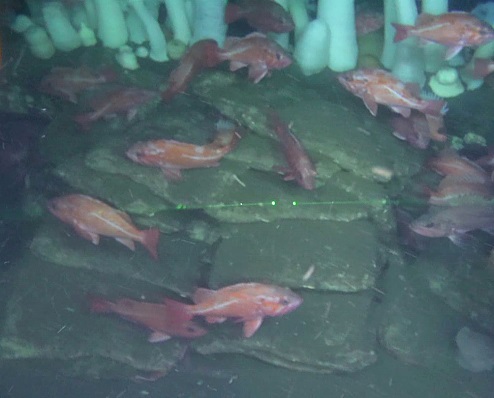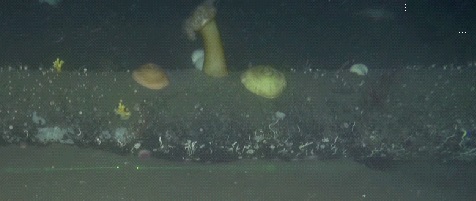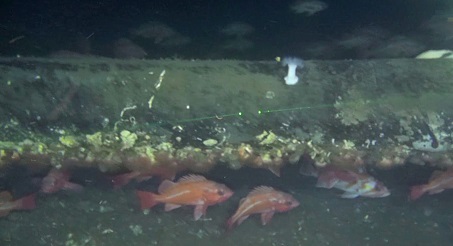
The deck crane aboard the Velero IV lowers us in the Delta, bumping and squeaking down the “tire mat.” We are near to platform Edith. Next, a loud click, and click as the supporting cable clips are unhooked, coms testing, gyro setting and we’re free. Sub pilot Chris James releases a bit of air from the ballast tanks and we start our descent.
At 160 feet we touch down on a soft mud bottom. There’s quite a bit of ambient light, but still not enough. The floods go on, some more coms with the surface and soon our objective is in sight.
The pipeline, an unassuming conduit of crude, extends between Platform Edith and Platform Ellen, the northerly of the “twin rigs” about a mile to the southeast. Our task is to count fish along the pipeline and record video of the scene.
The pipe is bare but for an occasional patch of anemones. Along the way it crosses over soft substrate with an occasional patch of cobble. It’s here we encounter massive schools of tiny rockfish — mostly half-banded and squarespot.
Most SoCal saltwater anglers are well aware of the fishing opportunities subsea pipelines can offer. These are places like the Goleta Pipe, El Segundo pipe, Newport Pipe, Buccaneer Pipe of Oceanside, Pt. Loma Pipe and many more. But what these “pipes” all have in common are a heavy layer of rock armor covering them. That’s what creates the great fish habitat.
In fact, owing to the difficulty of dropping rock from a barge, directly on top of a target, often much more rock is needed than originally estimated — 3x as much at Goleta for example.
Here there are sections where the rock-armor covers quite a bit of the area off to the side and forms a great wide spot of Catalina quarry rock along the pipeline. The quarry at Catalina is the place where the majority of all breakwater building and pipeline covering material comes from along the California Coast these days.

While it’s common for wastewater pipes to be armored in this way, it’s not always so, especially with regard to older systems and those connecting oil production platforms — between them, and ultimately to shore-side facilities.
These offshore oil pipelines are often bare. What I’ve seen is most are insulated by a coating of concrete, but for the oldest we’ve surveyed — the remnants remaining around the footprint of Platform Herman off the Gaviota Coast and running ashore from there.
In decommissioning such oil and gas production facilities pipelines are often left in place. Padre Associates Inc., an engineering firm with expertise in the field, presented a list of considerations with respect to “abandonment in place.” Key among these is whether “Environmental impacts associated with removal considered excessive in comparison to the benefit of removal.”
Recently we saw the tragic results of what is likely to have been an interaction between a large ship anchor and an unarmored offshore oil pipeline. This pipeline is laid through shallow waters very near an anchorage area for such ships.
In fact, it is downwind from the nearest and largest of such zones, given prevailing conditions in the area. The resultant Huntington oil spill illuminates the high stakes involved.
It is not uncommon for such unarmored pipelines to “span” as soft substrate is washed away, leaving a gap under the pipeline. Operating companies perform regular pipeline inspections using Remotely Operated Vehicles (ROVs), to identify such areas. If a spanned section is large enough to threaten pipeline integrity, “grout bags” are used to fill in and support the pipeline.
These are basically bags of pre-mix laid under and alongside, which with contact with seawater, wet and set. Spanning itself can result in ruptured pipelines and oil spills as was seen between platform Irene and shore, off Vandenberg in September of 1997.

Such “bare” pipelines do still provide some fish habitat along them, especially when there’s a gap between the pipe and the seafloor — even more so where grout bags are placed. Nevertheless, full armament not only protects the pipe from “spanning” and from dragging anchors in windy weather, but also provides a vast improvement to local fish habitat and coincidentally, vastly improved fishing opportunity for the public.
Both spanning and dragging anchors are much less of an issue in deep waters, say beyond 200 feet deep. Here the inspection and grout bag approach has proven entirely successful over the years.
Along the SoCal coastline, hard bottom is in short supply. Where it occurs it provides oases of fish and invertebrate density and diversity whatever and wherever it may be — much more than the soft substrate nearby.
Artificial rock piles of either quarry rock or broken concrete provide the best of such hard bottom, with lots of caves and voids and durable surfaces sessile invertebrates and algae attach to strongly. Shipwrecks and oil platforms seem to be the only substrate better for fish, mostly due to their even higher relief, spanning the water column.
Merit McCrea is saltwater editor for Western Outdoor News. A veteran Southern California partyboat captain, he is a marine research scientist with the Dr. Milton Love Lab at the University of California at Santa Barbara’s Marine Science Institute. He serves on the Groundfish Advisory sub-Panel of the Pacific Fisheries Management Council, the Santa Barbara Harbor Commission, The Channel Islands National Marine Sanctuary Advisory Council and the CCA-Cal State Board. He can be reached at: merit@wonews.com.



